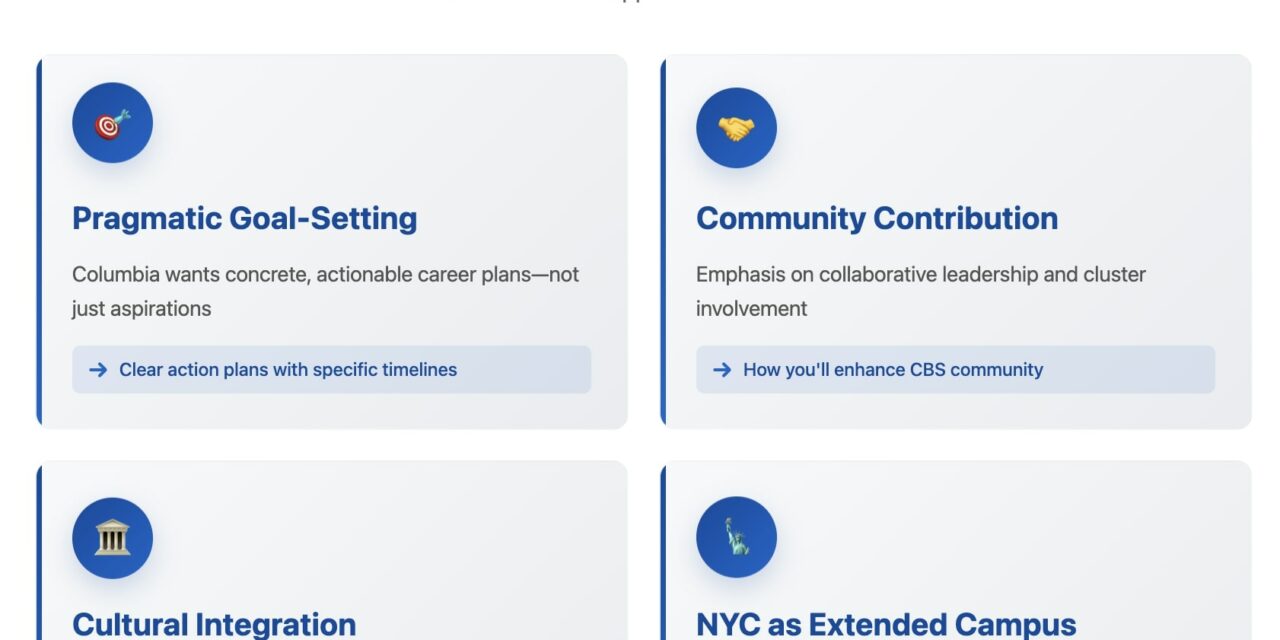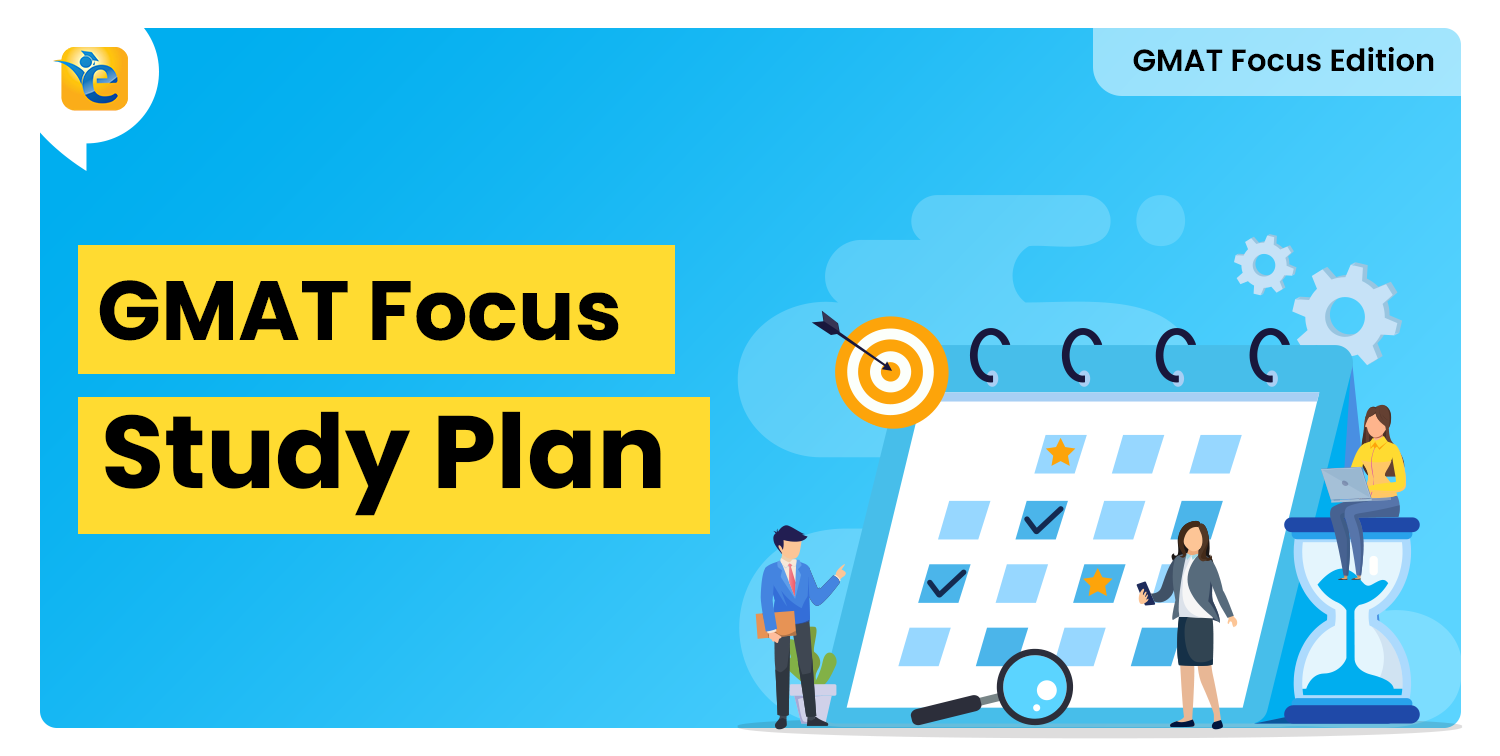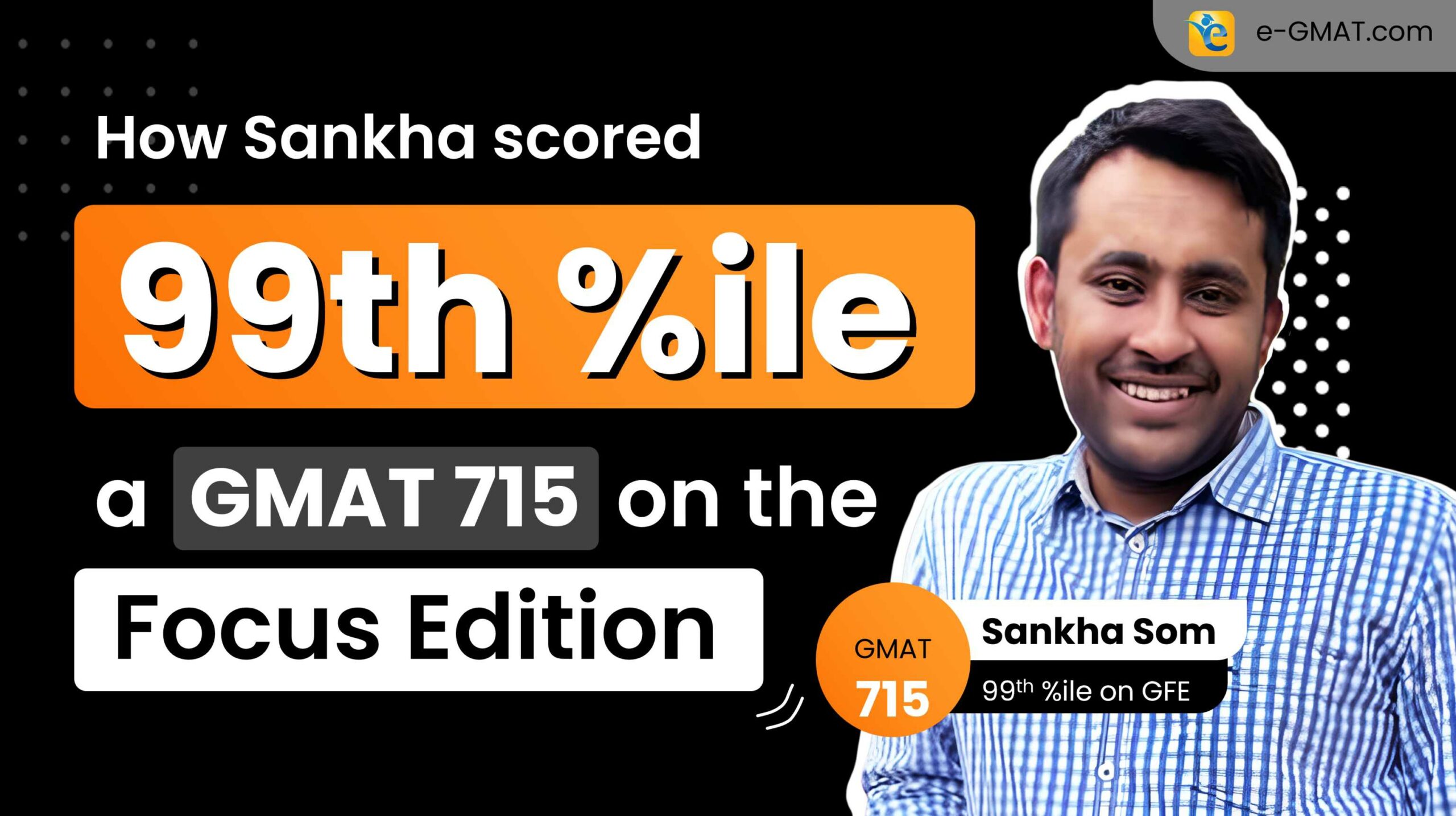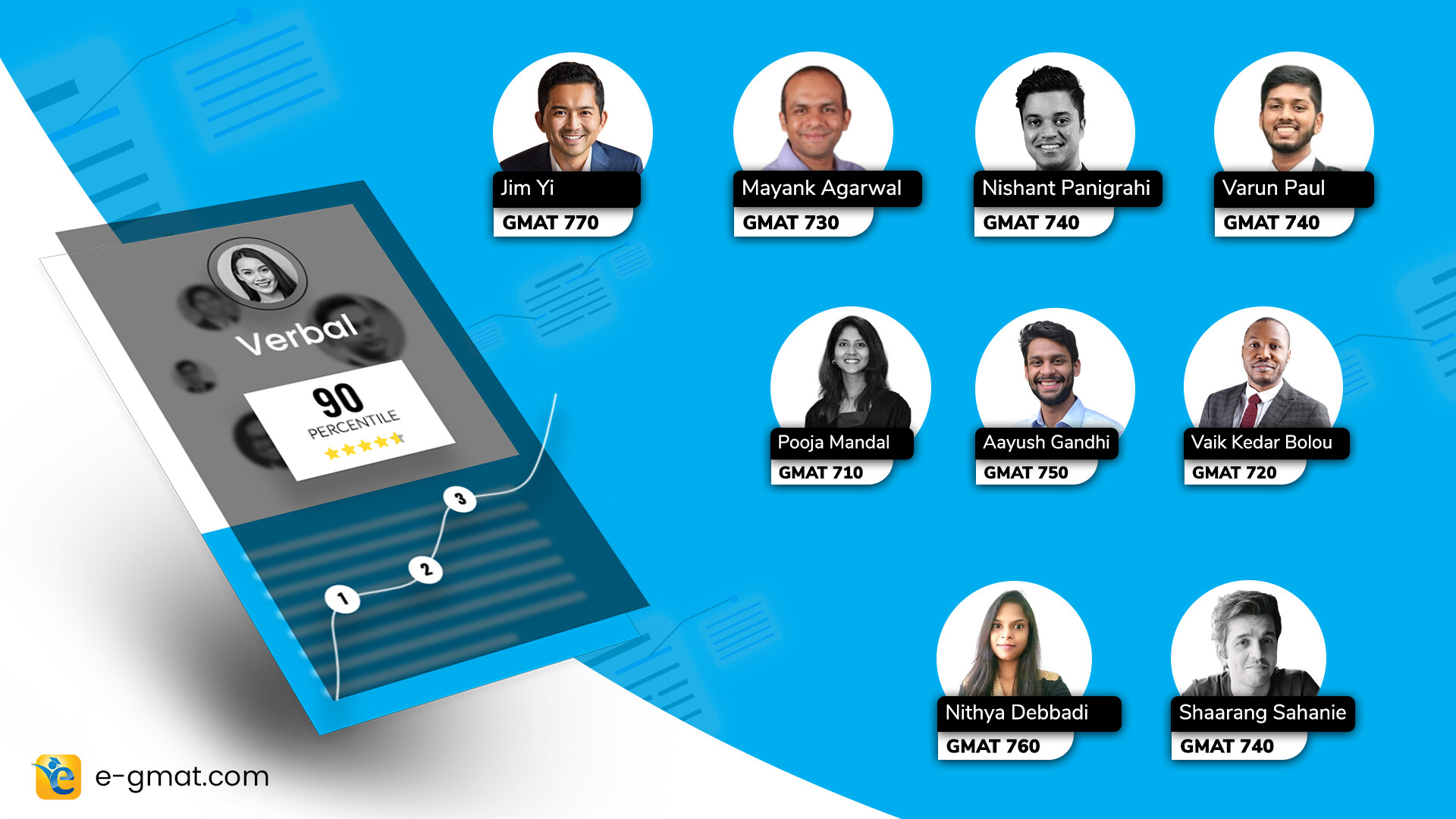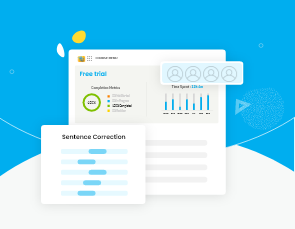The Columbia Business School MBA application is your gateway to one of the world’s most prestigious business programs. Located in Manhattan’s heart, Columbia attracts ambitious professionals who thrive in fast-paced environments and want to leverage New York City’s unparalleled opportunities.
For 2025-2026, crafting exceptional essays is more critical than ever. With thousands of qualified candidates competing for limited spots, your essays must showcase authentic fit with Columbia’s culture while positioning you as someone who will contribute meaningfully to this dynamic community.
⭐ Key Takeaways for your Columbia MBA Application:
- Position yourself as a contributor, not just a beneficiary: Show how you’ll actively enhance Columbia’s programs and communities rather than focusing solely on what you’ll gain from the MBA experience.
- Balance visionary thinking with practical execution: Showcase both competitive excellence and collaborative leadership to align with Columbia’s fast-paced NYC culture where ideas must be actionable.
- Conduct strategic research before writing: Network with current students and alumni, attend Columbia events, and map specific school resources to your goals to create authentic, well-informed essays.
⭐Maximize Your Columbia MBA Chances
Strong GMAT scores are crucial for Columbia’s competitive admissions. Get started with our comprehensive free GMAT prep package: 15+ hours of video lessons, 400 practice questions, and a full-length adaptive mock test.
- What Makes Columbia MBA Essays Unique
- 2025-2026 Columbia MBA Essay Requirements: Complete Breakdown
- Columbia MBA Short Answer Questions: Every Character Counts
- Columbia MBA Essays: Key Success Factors
- Understanding Columbia’s Culture
- Key Programs to Research
- Strategic Positioning: How to Communicate Your Best Fit?
- Your Action Plan
- Conclusion: Key Takeaways
- Frequently Asked Questions about Columbia MBA Program:
What Makes Columbia MBA Essays Unique
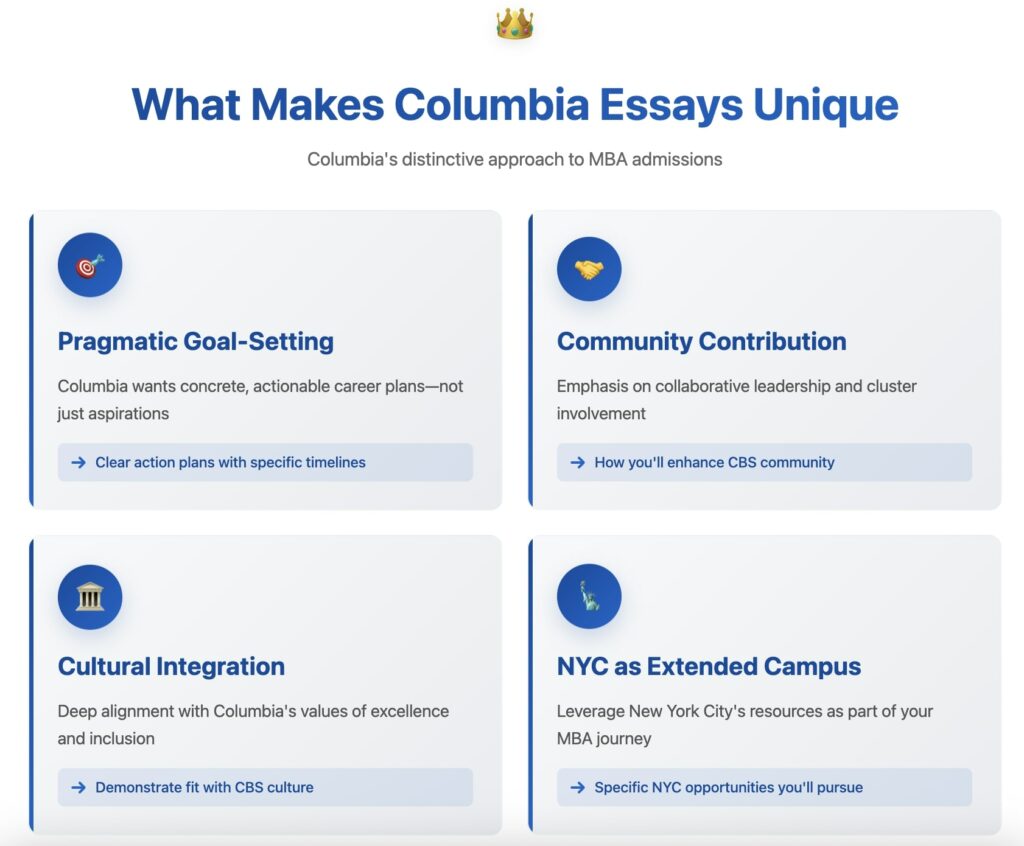
Columbia’s essay prompts stand out from other top business schools through their focus on:
- Pragmatic goal-setting with clear action plans
- Community contribution and collaborative leadership
- Cultural integration with Columbia’s values
- New York City leverage as an extended campus
⭐ Key Insight: Columbia doesn’t just want high achievers—they want partners who will actively shape the MBA experience and leave the program better than they found it.
2025-2026 Columbia MBA Essay Requirements: Complete Breakdown
Columbia has streamlined their requirements, using identical questions for both J-Term and August entry programs.
Quick Reference Guide
| Component | Length | Focus |
| Short Answer | 50 characters | Immediate post-MBA goal |
| Short Answer | 50 characters | Summer internship plans |
| Essay 1 | 500 words | Career goals (3-5 years + dream job) |
| Essay 2 | 250 words | Team collaboration example |
| Essay 3 | 250 words | How you’ll co-create at Columbia |
Columbia MBA Short Answer Questions: Every Character Counts
Question 1: “What is your immediate post-MBA professional goal? (50 characters maximum)”
Why This Matters: This question forms the foundation of your entire narrative. The extreme character limit forces you to eliminate generic language and be laser-focused.
| Strategy | Examples |
| ⭐ Choose specificity over comprehensiveness | ❌ “Strategy Consulting” (19 characters – too generic) |
| ➕ Include company type or function | ✅ “MBB Strategy Consultant” (24 characters – specific) |
| ⚡ Eliminate unnecessary words | ✅ “Bain Associate, Healthcare” (25 characters – even more targeted) |
Question 2: Summer Plans (50 characters maximum)
Strategy: Ensure perfect alignment with Question 1. If you said “Investment Banking Associate,” your summer should reflect “Goldman IBD Summer Associate.”
✅ Action Checklist:
- Aligns with post-MBA goal
- Specific company/industry mentioned
- Uses every available character efficiently
- Eliminates articles and filler words
Columbia MBA Essays: Key Success Factors
Columbia MBA Essay 1: Career Goals (500 words)
Prompt: “What are your career goals over the next three to five years and what is your long-term dream job?“
This essay has remained unchanged for eight years—Columbia knows what works. Focus on forward-looking analysis, not resume repetition.
Structure That Works
Word Allocation:
- 60% on 3-5 year goals (detailed planning)
- 40% on long-term vision (dream job)
Framework:
- Current capabilities (brief context)
- Short-term goals (specific, achievable)
- Long-term vision (inspiring but realistic)
- Columbia connection (why you need this MBA)
Key Success Factors
| ✅ Do This | ❌ Avoid This |
| ⭐ Provide specific examples of goal-relevant skills | ⛔ Repeating resume bullet points |
| ↗️ Show logical progression from current role | ⚠️ Vague goals like “make an impact” |
| ℹ️ Reference Columbia resources that enable goals | ❌ Ignoring why you need an MBA now |
| ⚡ Demonstrate market knowledge and trends | ❌ Generic business school benefits |
Columbia MBA Essay 2: Team Collaboration (250 words)
Prompt: “Share a specific example of how you made a team more collaborative, more inclusive or fostered a greater sense of community.”
This essay tests your ability to create positive change in team dynamics—a critical skill at Columbia.
STAR Method Breakdown
Word Allocation:
- Situation: 30% (brief context)
- Task: Minimal (implied in situation)
- Action: 50% (your specific contributions)
- Result: 20% (measurable outcomes)
What Columbia Wants to See
| What Columbia Wants to See | Strong Example Structure |
| ↗️ Before/after transformation you created | 1. Team challenge (2-3 sentences) |
| ⚡ Specific actions you took (not just what happened) | 2. Your specific interventions (most of essay) |
| ℹ️ Measurable results with numbers when possible | 3. Quantifiable results (1-2 sentences) |
| ⭐ Reflection on what you learned | 4. Lesson learned (1 sentence) |
Columbia MBA Essay 3: Co-Creating at Columbia (250 words)
Prompt: “How would you co-create your optimal MBA experience at CBS? Please be specific.”
This essay evaluates your research quality, cultural fit, and contribution potential.
The Three Dimensions
Columbia explicitly mentions three areas—weave them throughout:
- Academic: Specific courses, professors, research
- Cultural: Clubs, traditions, community building
- Professional: Networks, career resources, industry connections
Research-Driven Strategy
✅ Reference 3-4 Specific Columbia Resources:
- Professor names and their research
- Specific courses (not just “finance classes”)
- Student clubs and leadership roles
- Unique programs (Lang Center, Startup Lab)
- NYC partnerships and opportunities
Show Contribution, Not Just Benefit:
- How you’ll enhance these communities
- Skills you’ll bring to classmates
- Leadership roles you’ll pursue
- Knowledge you’ll share
Common Mistakes to Avoid in Columbia MBA Essays
The “Trap” Questions
Short Answers: Don’t underestimate these. They often require more revisions than longer essays due to the constraint.
Resume Repetition: Essay 1 says avoid repeating your resume, but this doesn’t mean avoiding all past experiences. Analyze how past experiences inform future goals—don’t just summarize them.
Generic School Praise
| ❌ Generic Examples | ✅ Specific Examples |
| “Columbia’s prestigious reputation” | “Professor X’s research on fintech regulation” |
| “Access to New York opportunities” | “Wall Street Trek program with Goldman Sachs” |
| “Learn from diverse classmates” | “Leading the Healthcare Club’s McKinsey case competition” |
Understanding Columbia’s Culture
Core Values in Action – Beyond the Mission Statement
Innovation + Practicality: The Columbia Advantage
Columbia doesn’t just want visionary thinkers—they want visionaries who can execute in Manhattan’s fast-paced business environment. This means:
- Show both sides: Demonstrate big-picture thinking AND practical implementation skills
- Use the STAR+ method: Situation, Task, Action, Result, plus Strategic Thinking component
- Example approach: “I identified a market gap (vision) and built a pilot program that generated $500K revenue in 6 months (execution)”
Collaboration + Competition: The NYC Intensity Factor
The environment is intensely competitive but fundamentally collaborative. Successful applicants demonstrate:
- Competitive excellence: Top performance in demanding environments
- Collaborative leadership: Making teams better, not just achieving individual success
- Stress-test your examples: Choose stories that show both individual achievement AND team elevation
Diversity + Unity: The Bridge-Builder Profile
Columbia values candidates who bring unique perspectives while building connections:
- Cultural translator skills: Show how you’ve bridged different groups, perspectives, or cultures
- Unique + Universal: Highlight what makes you different while showing how you connect with others
- Avoid the “diversity statement” trap: Don’t just mention diversity—show how you actively create inclusive environments
Key Programs to Research
Academic Innovation Deep Dive
| Program Component | Details | Research Strategy | Essay/Action Application |
| ⭐ Cluster System | • 65-student learning communities for core courses • Creates intimate environment within large program | Contact current students in clusters related to your industry | Show how you’ll contribute to small-group learning dynamics |
| ↗️ Cross-Registration Opportunities | • Journalism School (for media/content careers) • School of International and Public Affairs (for consulting/policy careers) • Engineering School (for tech careers) | ✅ Action item: Identify specific courses outside CBS that align with your goals | Connect entrepreneurial goals to specific Columbia resources and mentorship opportunities |
| ⚡ Experiential Learning Programs | • Columbia Entrepreneurship Organization (CEO) • Columbia Investment Management Program • Social Enterprise programs | ℹ️ Research tip: Find alumni who participated in programs relevant to your goals | Demonstrate understanding of NYC advantage and how you’ll leverage specific industry connections |
Entrepreneurship Ecosystem Research:
Eugene Lang Entrepreneurship Center:
- Venture labs and incubator programs
- Funding competitions and pitch events
- Mentorship networks with successful entrepreneurs
- Specific research: Look up recent Startup Lab participants and their ventures
- 10-week intensive program
- $15,000 in funding for accepted ventures
- Co-working space and mentorship
- Application relevance: Show how your venture idea fits their focus areas
- Columbia Business School Angels
- Connections to major NYC VC firms
- Alumni network in startup ecosystem
- Networking strategy: Attend Columbia startup events to meet participants
NYC Integration Specifics:
| Industry Focus | Details | Research/Action Application |
| Wall Street Immersion | • Finance Trek programs to major firms • Guest lectures from industry leaders • Internship pipeline to top financial institutions | ⭐ Research target: Identify specific firms and roles accessible through Columbia |
| Silicon Alley Connections | • Tech company partnerships • Product management pipeline programs • Digital innovation workshops | ✅ Action item: Research Columbia alumni at target tech companies |
| Cultural Institution Partnerships | • Columbia Arts & Culture track • Partnerships with museums, theaters, media companies • Entertainment and media industry access | ➡️ Unique angle: Show how these connections align with your goals |
Strategic Positioning: How to Communicate Your Best Fit?
Creating Your Unified Narrative
Choose 2-3 core themes that will thread through all essays:
Popular Theme Combinations:
- Innovation + Leadership + Social Impact
- Analytical Thinking + Cross-Cultural Skills + Entrepreneurship
- Financial Expertise + Technology + Global Perspective
Addressing Common Weaknesses
Academic Concerns:
- Highlight quantitative work experience
- Reference specific prep work you’ve done
- Show intellectual curiosity through examples
Leadership Gaps:
- Focus on influence without authority
- Highlight initiative-taking examples
- Demonstrate leadership potential vs. just titles
Goal Feasibility:
- Provide detailed implementation plans
- Show relevant preparation steps
- Reference specific Columbia resources
Success Profiles: Key Strategies
| Background | Main Challenge | Winning Strategy | Key Takeaway |
| Investment Banking | Differentiation from similar candidates | Positioned banking as strategic entrepreneurship prep; showed genuine deal engagement | Authenticity over strategy |
| Non-Profit | Demonstrating business readiness | Emphasized transferable skills + quantitative achievements | Highlight unexpected strengths |
| Consulting | Avoiding “typical consultant” narrative | Focused on specific client impact + skill gaps MBA would fill | Show unique value proposition |
✅ All Winners Did This:
- Demonstrated genuine passion for stated goals
- Referenced specific Columbia resources extensively
- Showed clear contribution plans beyond personal benefit
- Addressed potential concerns proactively
Your Action Plan
Week 1: Foundation Research
- Join Columbia Business School groups on LinkedIn
- Follow 10 Columbia professors whose research aligns with your interests
- Identify 5 current students or recent alumni to contact
- Sign up for Columbia webinars and information sessions
Week 2: Program Deep Dive
- Research specific courses in your areas of interest
- Identify 3-4 student clubs you’d want to join and lead
- Find Columbia-specific opportunities (competitions, programs, centers)
- Create a list of 10 specific Columbia resources to mention in essays
Week 3: Network Building
- Reach out to alumni in your target industry/function
- Attend virtual Columbia events
- Connect with current students through official channels
- Prepare specific questions about Columbia culture and opportunities
Week 4: Strategic Application
- Map your research to specific essay responses
- Identify your unique contribution to Columbia community
- Develop your “Why Columbia” narrative with specific details
- Validate your understanding with alumni conversations
⏱️Week 5: Optimize Your GMAT Timeline
While planning your essay strategy, don’t forget your GMAT preparation. Create a personalized study plan that fits your Columbia application timeline and maximizes your score potential.
Conclusion: Key Takeaways
Remember: Columbia’s admissions committee wants to admit students who will succeed. Your essays should demonstrate both capability and character.
Your Unique Value: Focus on what makes you genuinely different rather than trying to fit an “ideal candidate” mold.
The Partnership Approach: Columbia sees students as partners in education. Show how you’ll actively contribute to the community’s success.
Beyond Admission: Approach these essays with the same thoughtfulness you’ll bring to your future business leadership roles. The committee is looking for future industry leaders—show them that leader is you.
Ready to Start?
Begin with thorough research of Columbia’s specific programs that align with your goals, then use this framework to craft essays that authentically represent your unique value while demonstrating genuine fit with Columbia’s extraordinary community.
The 2025-2026 application cycle offers unique opportunities for candidates who understand Columbia’s priorities and can articulate clear value propositions. Your Columbia MBA journey begins with these essays—make them count.
⚡Complete Your Columbia Application Strategy
Your essays are just one piece of the puzzle. Strengthen your entire application with our comprehensive free GMAT prep resources:
- 400+ practice questions with detailed explanations
- Full-length adaptive mock tests
- Personalized study planning tools
- AI-powered weakness identification
Frequently Asked Questions about Columbia MBA Program:
Yes, Columbia MBA admission is highly competitive. The program attracts thousands of qualified candidates competing for limited spots, making exceptional essays more critical than ever for the 2025-2026 cycle. Columbia seeks ambitious professionals who thrive in fast-paced environments and want to leverage New York City’s unparalleled opportunities.
The school doesn’t just want high achievers—they want partners who will actively shape the MBA experience and contribute meaningfully to the dynamic community. Success requires demonstrating authentic fit with Columbia’s culture while positioning yourself as someone who will leave the program better than you found it.
Columbia offers both J-Term (January start) and August entry MBA programs, both using identical application requirements for 2025-2026. The J-Term program represents Columbia’s accelerated MBA option, providing a faster path to graduation compared to the traditional two-year program.
Both programs provide access to the same prestigious Columbia Business School experience in Manhattan’s heart, with identical essay requirements and admission standards. Students in both programs benefit from Columbia’s unique culture combining innovation with practicality, collaboration with competition, and diversity with unity.
Columbia Business School has an acceptance rate of approximately 19-20%, making it highly selective among top MBA programs. The Class of 2025 welcomed 900 students (681 August entry, 219 January entry) from 5,895 applications. This competitive landscape reflects Columbia’s position as an M7 school attracting global talent.
The admissions process emphasizes holistic evaluation beyond test scores, seeking candidates with strong leadership potential, professional achievements, and authentic alignment with Columbia’s collaborative culture. Success requires demonstrating not just academic excellence but also unique experiences and clear contribution potential to the CBS community.
Columbia MBA graduates achieve exceptional career outcomes with a median starting salary of $175,000 for the Class of 2024. 89% of students seeking employment received job offers within three months of graduation, with 86.4% accepting positions.
Industry breakdown shows 35.9% joining financial services and 30.6% entering consulting, sectors commanding premium compensation often exceeding $200,000 total packages. Technology attracts 10% of graduates with competitive packages. Location impacts vary: 79% stay in the U.S., 9% head to Asia, and 5% to Europe. The strong alumni network and NYC location create pathways to top-tier positions across industries.
Yes, Columbia University is a founding member of the Ivy League, and Columbia Business School benefits from this prestigious institutional affiliation. This status provides students with extensive academic resources, world-class faculty, and an influential global alumni network spanning major industries.
The Ivy League designation enhances CBS’s already strong reputation, opening doors to exclusive opportunities and elite corporate partnerships. Students gain access to Columbia’s broader university resources, cross-registration opportunities, and the intellectual prestige associated with one of America’s most distinguished educational institutions. This combination of business school excellence and Ivy League heritage creates unparalleled opportunities for career advancement.
Columbia requires either GMAT or GRE scores for MBA admission – both are equally accepted with no preference stated. The average GRE scores are 162 Verbal and 162 Quantitative for admitted students. GMAT averages 732 for the Class of 2026. Columbia also accepts GMAT Focus Edition alongside GMAT Classic.
Test scores must be valid and self-reported during application submission, with official scores required if admitted. No test waivers are available – standardized testing is mandatory. International students should also submit TOEFL/IELTS if English isn’t their native language. The admissions committee uses test scores as one component of holistic evaluation alongside essays, recommendations, and professional experience.
Yes, Columbia MBA requires interviews, but they are by invitation only and cannot be requested. The Admissions Office contacts selected candidates to schedule interviews. Interviews are conducted virtually by current second-year MBA students, alumni, or admissions team members.
For January entry applicants, interview invitations or denial decisions are released as soon as possible after each round deadline. August entry interview timeline updates are posted on the Options and Deadlines page throughout the cycle. Interview invitations are based on comprehensive application review, making strong essays, recommendations, and demonstrated fit with Columbia’s culture crucial for advancing to this stage.
Yes, Columbia Business School’s full-time MBA program is officially STEM-designated, applying to all MBA students regardless of chosen electives or concentrations. This designation, effective retroactively to May 2019 graduates, reflects Columbia’s integration of data science, technology, and analytics throughout the curriculum.
International students (45% of the class) benefit from up to 3 years of work authorization through extended Optional Practical Training (OPT) – 1 year standard plus 2-year STEM extension. The designation recognizes how technology and data analytics affect all business aspects, from investment and marketing to artificial intelligence and energy innovation. This status significantly enhances post-graduation employment opportunities for international students.
The Columbia MBA represents a significant investment with 2024-2025 tuition at $88,300 annually .. Total estimated cost reaches $132,258 for August entry and $126,102 for January entry first-year students, including mandatory fees ($5,857 August, $5,133 January), health insurance ($4,541), books, and living expenses.
Two-year total program cost approaches $257,409, making it among the most expensive MBA programs globally. However, this investment yields exceptional ROI with graduates earning median $175,000 starting salaries and 135% salary increases. Columbia offers need-based aid ($10,000-$30,000 awards) and merit fellowships. The premium reflects Manhattan location, world-class faculty, and unparalleled industry access.
The average GMAT score for Columbia’s Class of 2026 is 732, reflecting the highly competitive applicant pool. The middle 80% range typically spans 700-760, indicating most admitted students score well above 700. Columbia accepts both GMAT Classic and GMAT Focus Edition with no stated preference.
The school also accepts GRE scores (average 162 Verbal, 162 Quantitative). The average undergraduate GPA is 3.6 for domestic applicants. International applicants should aim for similar or higher scores due to increased competition. While test scores are important, Columbia uses holistic admissions considering leadership, professional achievement, and cultural fit alongside academic metrics.
No, Columbia MBA uses three distinct application rounds with fixed deadlines, not rolling admissions:
Round 1: September 3, 2025
Round 2: January 6, 2026
Round 3: March 26, 2026
January entry (J-Term) has separate deadlines: June 17 and August 13, 2025. However, applications are reviewed in a “rolling nature” within each round, meaning earlier submissions may have competitive advantages. Round 1 and 2 applications receive priority consideration for institutional funding. All application materials, including recommendations and the $250 fee, must be completed by 12:00 PM ET on deadline dates. Late applications automatically roll to the next available round.
Columbia offers two MBA formats: the traditional 24-month August entry program and the accelerated 16-month January entry (J-Term) program. The August program includes a summer internship between first and second years, appealing to career changers. About 70% of students choose August entry.
The J-Term program suits professionals not needing summer internships or those remaining in their current industry. About 30% select January entry. Both formats cover identical curriculum and lead to the same MBA degree. Students are grouped into clusters for core courses, creating collaborative learning environments. The program emphasizes experiential learning through NYC immersion, global opportunities, and extensive industry partnerships.


